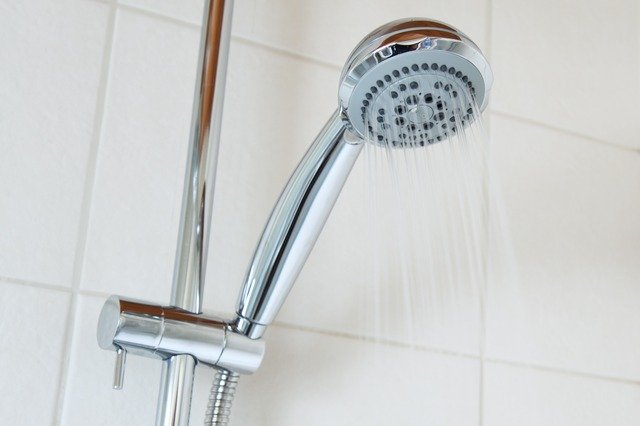A clogged drain can quickly turn your relaxing shower into a frustrating mess. But here’s the good news—you don’t need harsh chemicals to fix the problem. In fact, you likely already have everything you need at home to clear it out safely and effectively.
Imagine a solution that’s not only eco-friendly but also easy on your wallet. Sounds good, right? In this guide, you’ll learn simple, proven methods to unclog your shower drain without exposing yourself or your pipes to harmful chemicals. Stick around, because by the end, you’ll feel confident tackling this common issue on your own. Let’s get that water flowing again!
Table of Contents
Common Causes Of Shower Drain Clogs
Understanding why shower drains clog can help prevent future blockages. Clogs happen over time, often due to everyday habits. Below are the most common culprits that lead to a slow or completely blocked drain.
1. Hair Buildup
Hair is the top cause of clogged shower drains. It gets caught in the drain and tangles with soap scum. Over time, this creates a stubborn blockage. Short or long, all types of hair can contribute to this issue.
2. Soap Scum
Soap contains oils and fats that can solidify in pipes. When mixed with hair or dirt, it forms a sticky residue. This residue coats the walls of the drain, reducing water flow.
3. Dirt And Sand
Washing off dirt or sand after outdoor activities can clog your drain. These particles settle at the bottom of the pipe, building up over time. They mix with other debris, making the blockage worse.
4. Hard Water Deposits
Hard water leaves behind mineral deposits in your pipes. These deposits narrow the drain opening, causing water to back up. The buildup also traps other materials like hair and soap scum.
5. Small Objects
Small items like jewelry, bottle caps, or plastic bits can accidentally fall into the drain. These objects block water flow and create a clog. They are often difficult to remove without tools.

Credit: www.familyhandyman.com
Essential Tools For Clearing A Drain
Clogged shower drains can be frustrating, but fixing them doesn’t need to involve harsh chemicals. With the right tools, you can tackle the blockage yourself and keep your bathroom eco-friendly. You might even find the process satisfying—like solving a little household mystery!
1. Basic Plunger
A plunger is a simple yet effective tool for dislodging clogs. Opt for a small-sized plunger designed for sinks or tubs, as it fits better in a shower drain. Press it firmly over the drain, create a seal, and pump several times to loosen the debris. You’ll feel a sense of accomplishment when you hear that satisfying gurgle indicating success!
2. Drain Snake Or Auger
If the clog is deeper, a drain snake can come to your rescue. These flexible tools can reach into the pipe and hook onto hair or soap buildup. Insert the snake slowly, twist it a bit, and pull back. You might be surprised (or slightly grossed out) by what comes out! Have a trash bag handy for disposal.
3. Screwdriver
A screwdriver is essential for removing the drain cover. Most shower drains have screws holding the cover in place. Use the appropriate size screwdriver to unscrew them without damaging the cover. Once the cover is off, you’ll have better access to the blockage.
4. Rubber Gloves
Clog-clearing can get messy, so don’t forget your rubber gloves. They protect your hands from grime and keep things hygienic. Thick, reusable gloves work best—they’re durable and easy to clean afterward. You’ll thank yourself later when you’re not scrubbing your hands endlessly!
5. Flashlight
Ever tried peering into a dark drain without proper lighting? It’s almost impossible to see what you’re dealing with. A small flashlight helps you inspect the blockage and assess whether you need a snake or just some elbow grease. Keep it handy for precision work.
6. A Bucket Of Hot Water
Hot water can work wonders on minor clogs caused by soap scum or grease. After clearing the blockage, pour hot water into the drain to flush out any residue. It’s a simple step that ensures the drain is completely unclogged and ready for use.
Are you feeling ready to tackle your clogged shower drain now? With these tools at hand, you can handle the issue confidently without relying on harsh chemicals. What’s stopping you from giving it a try today?
Using A Plunger Effectively
Clogged shower drains can be frustrating. A plunger is a simple, effective tool to handle this problem. It clears blockages without chemicals, keeping your pipes safe. Using a plunger correctly ensures better results and saves time. Below is a step-by-step guide to help you use a plunger effectively.
Preparing The Shower Drain
Before plunging, remove the drain cover. This gives better access to the clog. Check for visible debris like hair or soap scum. Use gloves to pull out anything you can by hand. Filling the shower with a few inches of water helps the plunger create a seal. This step is crucial for effective suction.
Choosing The Right Plunger
Not all plungers work for shower drains. A cup-style plunger is best for flat surfaces. Ensure the plunger’s rubber cup is free from cracks. A clean plunger improves suction and hygiene. Avoid using a toilet plunger, as it may not seal properly.
Plunging With Proper Technique
Place the plunger firmly over the drain. Ensure it covers the opening entirely. Push down gently, then pull up with force. Repeat this motion 10–15 times. This creates pressure to dislodge the clog. Stop occasionally to check if the water is draining.
Testing The Drain
After plunging, run water to test the drain. If it flows freely, the clog is cleared. If not, repeat the process or try another method. Always clean the plunger after use to maintain hygiene.

Credit: www.youtube.com
Cleaning The Drain Cover
A clogged shower drain often starts with a dirty drain cover. Over time, soap scum, hair, and debris collect on it. Cleaning this part can help improve water flow instantly. It’s a simple but essential step to unclogging your drain.
Step 1: Remove The Drain Cover
Use a screwdriver to unscrew the cover, if secured with screws. Some covers can be lifted by hand. Be gentle to avoid damaging the surrounding area. Set the cover aside for cleaning.
Step 2: Scrub The Drain Cover
Rinse the cover under warm water to remove loose debris. Use an old toothbrush to scrub away stuck-on grime. Dish soap works well for breaking down grease and dirt. Make sure to clean every corner of the cover.
Step 3: Inspect For Hidden Buildup
Check the underside of the cover for hidden hair or soap scum. These areas are often missed and can block water flow. Clean thoroughly to ensure no debris is left behind.
Step 4: Dry And Replace The Cover
Use a clean towel to dry the cover completely. Align it back onto the drain opening and secure it. Ensure it’s fitted snugly to prevent further clogs.
Removing Hair And Debris By Hand
Clogged shower drains can be a headache, especially when water starts pooling around your feet. But before reaching for harsh chemicals, why not try removing the blockage by hand? It’s surprisingly simple, effective, and much safer for your pipes and the environment. Plus, you might save yourself a trip to the store. Let’s dive into the steps to manually clear hair and debris from your drain.
Step 1: Gather Your Tools
Before you get started, make sure you have what you need. A pair of rubber gloves is essential—trust me, you’ll thank yourself later. You might also want to grab a flashlight to spot the clog if it’s deeper in the drain.
Don’t forget a pair of tweezers or a small hook. These can help pull out stubborn bits of hair and debris that your fingers can’t reach.
Step 2: Remove The Drain Cover
If your shower has a drain cover, it’s time to take it off. In many cases, you can simply lift it out. If it’s screwed in, grab a screwdriver and carefully remove it.
Once the cover is off, shine your flashlight into the drain. This will help you locate the clog and assess how bad it is.
Step 3: Pull Out Hair And Debris
Using your gloved hands, reach into the drain and start pulling out any visible hair and gunk. Don’t worry—it’s not as bad as it sounds, and you’ll feel pretty accomplished afterward.
If the clog is deeper, use your tweezers or hook to fish out the debris. You might need to repeat this process a few times to get it all out.
Step 4: Rinse And Test
Once you’ve removed the blockage, pour some water down the drain to see if it flows freely. If the water still pools, there might be more debris you need to tackle.
Repeat the steps until the water drains smoothly. It’s worth the effort to avoid using harsh chemicals that can harm your pipes.
Removing hair and debris by hand may not be glamorous, but it’s effective. Plus, you’ll feel great knowing you’ve solved the problem without damaging your plumbing—or the planet. Next time your shower drain clogs, you’ll know exactly what to do.
Using A Drain Snake Or Hook
Clogged shower drains can be a real nuisance, but you don’t always need harsh chemicals to fix the problem. One of the most effective and eco-friendly solutions is using a drain snake or hook. This method is simple, affordable, and surprisingly satisfying when you see just how much debris you pull out of your drain.
What Is A Drain Snake Or Hook?
A drain snake, also known as a plumber’s snake, is a flexible tool designed to reach deep into pipes to remove clogs. A hook, on the other hand, can be something as simple as a bent wire hanger. Both tools are perfect for tackling hair, soap scum, and other common shower drain blockages.
How To Use A Drain Snake
First, insert the snake into the drain opening. Push it gently but firmly until you feel resistance. That’s likely the clog.
Turn the handle on the snake to latch onto the debris. Slowly pull it out, and you’ll probably be surprised by how much hair and grime has accumulated. Repeat the process if needed.
Making Your Own Hook
No drain snake? No problem. Take a wire hanger and straighten it out, leaving one end bent into a small hook.
Insert the hook into the drain and fish around for the clog. Once you snag something, carefully pull it out. Dispose of the waste in the trash—not back down the drain.
Pro Tips For Success
- Wear gloves to avoid touching the gunk directly.
- Shine a flashlight into the drain for better visibility.
- Clean your tools thoroughly after use to prevent rust or bacteria buildup.
Why This Method Works
Hair and soap scum are the usual culprits behind clogged drains, and they often clump together just below the surface. A drain snake or hook physically removes these blockages, addressing the root cause of the issue. Unlike chemicals, this method doesn’t harm your pipes or the environment.
Next time your shower starts draining slowly, why not give this a try? You might even find it oddly satisfying to clear the blockage yourself. Have you ever used a drain snake or hook before? It could be the DIY hack you didn’t know you needed!
Pouring Boiling Water Down The Drain
Sometimes, a clogged shower drain can ruin your day. You stand there, ankle-deep in water, wondering how to fix it without harsh chemicals. One simple solution is pouring boiling water down the drain. This technique is affordable, safe, and surprisingly effective. Let’s break down how it works.
Why Boiling Water Works
Boiling water can dissolve soap scum and loosen grime that builds up inside the drain. It’s especially helpful for minor clogs caused by hair, dirt, or grease. The heat breaks down these substances, allowing them to flow more easily through your pipes.
It’s also a great first step before trying other methods. Think of it as giving your drain a warm-up before tackling bigger blockages.
How To Do It Safely
Safety is key when handling boiling water. Never pour it directly from the kettle into the drain—it’s easy to spill and burn yourself. Instead, use a heat-resistant jug or container to transfer the water carefully.
Start by boiling a full kettle of water. Slowly pour the water down the drain in stages, pausing between pours. This helps the hot water target the clog without overwhelming the pipes.
When Boiling Water Might Not Work
If your drain is severely clogged, boiling water may not be enough. Thick blockages like tangled hair or solid debris might need a different approach. You might notice the water pooling instead of draining—this is a sign to try another method.
Also, avoid using boiling water if your pipes are made of PVC. The heat can warp or damage plastic pipes, leading to costly repairs.
Tips For Better Results
- Clean your drain cover first to remove visible debris.
- Repeat the boiling water process a few times if the clog persists.
- Follow up with a drain snake or baking soda and vinegar for stubborn clogs.
Have you tried pouring boiling water down your drain before? If you haven’t, it’s worth a shot next time your shower drain slows down. This simple trick could be the low-effort solution you didn’t know you needed.

Credit: www.younghouselove.com
Baking Soda And Vinegar Solution
Clogged shower drains can disrupt your daily routine. Chemicals are effective, but they may harm your pipes or the environment. A natural alternative involves baking soda and vinegar. This method is safe, budget-friendly, and easy to use.
Baking soda and vinegar react to break down grime and debris. You only need two common items from your kitchen. Follow the steps carefully for effective results.
Step 1: Gather Supplies
Collect baking soda, white vinegar, and hot water. You also need a stopper or rag to cover the drain. These items are inexpensive and often already available at home.
Step 2: Prepare The Drain
Remove the drain cover to access the clog. Use gloves to pull out visible hair or debris. Cleaning manually helps the solution reach deeper blockages.
Step 3: Add Baking Soda
Pour half a cup of baking soda directly into the drain. Baking soda works as an abrasive cleaner and deodorizer. Ensure it settles into the clog.
Step 4: Pour Vinegar
Add one cup of white vinegar into the drain. The reaction between vinegar and baking soda creates fizzing. This fizzing helps break down dirt and grease.
Step 5: Cover The Drain
Use a stopper or rag to seal the drain opening. This traps the reaction inside, focusing the cleaning power. Leave it for 15-30 minutes to work effectively.
Step 6: Flush With Hot Water
Boil water and carefully pour it down the drain. Hot water clears away loosened debris and helps flush the pipes. Repeat if necessary until water flows freely.
Step 7: Test The Drain
Run water to check if the clog is gone. If the drain is still slow, repeat the process. Baking soda and vinegar work well for minor to moderate clogs.
Preventing Future Clogs
Shower drain clogs can be a hassle to deal with. Preventing them saves time, effort, and frustration. A few simple habits can keep your drain flowing smoothly. These practices are easy to follow and effective over the long term.
Installing A Drain Screen
A drain screen is a small, inexpensive tool that blocks debris. It catches hair, soap residue, and other particles before they enter your pipes. Choose a screen that fits securely over your shower drain. Ensure it stays in place during use.
Clean the drain screen regularly to maintain its efficiency. Remove the trapped debris and rinse it under running water. Doing this weekly prevents buildup that could lead to clogs.
Regular Cleaning Routine
Keeping your shower drain clean reduces the risk of clogs. Create a weekly routine to clear out any debris. Remove visible hair or residue after each shower. This simple step can make a big difference.
Flush the drain with hot water once a week. This helps dissolve soap scum and clears minor blockages. A clean drain ensures water flows freely without interruption.
Frequently Asked Questions
How Do You Unclog A Shower Drain Naturally?
Pour a mixture of baking soda and vinegar down the drain. Wait 15 minutes, then flush with hot water.
Why Should You Never Use Baking Soda And Vinegar To Unclog A Drain?
Baking soda and vinegar can create pressure but often fail to clear tough clogs. Their reaction may damage pipes.
How Do You Unclog A Drain Without Chemicals?
Use a plunger or drain snake to remove blockages. Pour boiling water mixed with baking soda and vinegar. Clean debris.
What Will Dissolve Hair In A Shower Drain?
Pour a mixture of baking soda and vinegar down the drain. Let it sit, then flush with hot water. Use a drain snake or hair dissolving drain cleaner for tough clogs. Avoid harsh chemicals to protect pipes. Regular maintenance prevents buildup effectively.
Conclusion
Clearing a clogged shower drain doesn’t need harsh chemicals. Simple tools and methods can handle most blockages. Regular cleaning helps prevent future clogs and keeps water flowing smoothly. Try using a plunger, wire hanger, or baking soda and vinegar mix.
These solutions are effective, safe, and budget-friendly. Always check for hair or debris buildup to avoid bigger issues. A little effort now can save time and money later. Keep your shower drain clean, and enjoy hassle-free showers every day.







